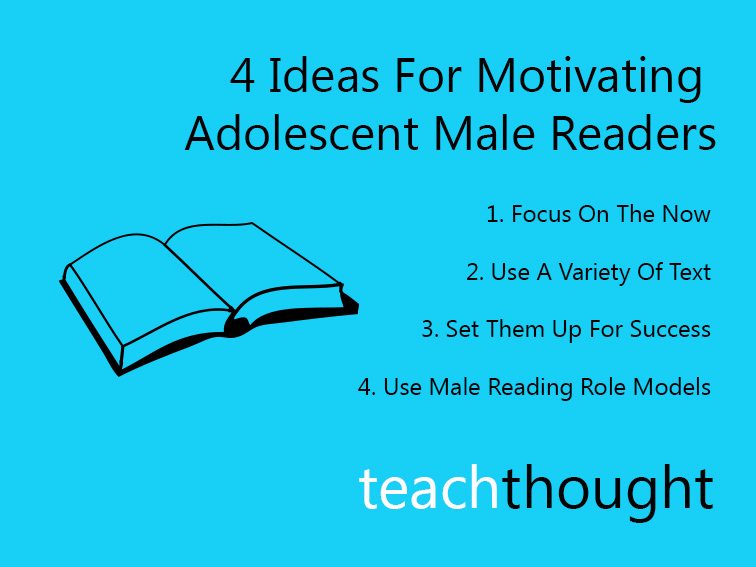
4What Are The Best Ideas For Motivating Adolescent Male Readers?
contributed by Kenny McKee
It’s no secret that state and national assessments continue to indicate that male readers lag behind female readers in literacy and literacy skills.
The gap tends to grow larger as students enter adolescence. It’s also no secret that many students dislike reading — in class or at home. Just ask a high school teacher…or a teenage boy. While it’s not true that all teenage boys dislike reading, there is a growing trend of many becoming unmotivated readers.
Obviously, students who are resistant to reading are unlikely to get better at it. Here are four ideas for motivating adolescent male readers.
4 Ideas For Motivating Adolescent Male Readers
1. Focus On The Now
Oftentimes, teachers emphasize the importance of reading skills or reading content by saying, “You will need this for the test,” or “You will need this for college,” or “When you get to the real world, you’ll need to be able to do this.” Well, students are living in the real world right now and for the most part, they have real concerns about their lives that they want to solve.
Many boys (and teenagers overall) like to know how learning impacts their lives in the moment, and they are generally not concerned with how schoolwork relates to an unclear future. Focusing on the future can lead to procrastination, since, to young men, the future seems a long time away (Smith & Wilhelm, 2002). Also, teachers can lose focus on students’ needs in the present.
We can make the reading we choose for whole-class instruction more motivating by relating it to the ‘here and now.’ Survey your students to determine what they want to learn, and select reading materials aligned with their interests. Have students—male and female readers—create products, presentations, or skits from their reading materials.
Many boys will readily engage in activities that ask them to create something meaningful or to perform for their peers. Also, consider designing inquiry units where students research answers to questions that concern teens, such as “Is the senior year of high school necessary?” or “Is love really all you need?” Weaving literature and informational texts around such topics can motivate many students, especially if students have some voice in what the inquiry topics will be.
2. Use A Variety Of Text
In some schools, there is a narrow view of what constitutes literacy. Even with the adoption of Common Core State Standards that emphasize informational text, the primary focus of secondary English language arts classes, especially in high schools, is often the study of literature. Male readers engage in many other forms of literacy that traditionally are not valued by teachers. Since many boys do not read teacher-privileged literary fiction texts at home, many of them classify themselves as non-readers, even if they do extensive reading from the Internet, magazines, and newspapers (Cavazos-Kottke, 2005).
One solution that can have tremendous positive effects on motivation is incorporating self-selected reading as part of the English language arts classroom. Conferring with students individually over self-chosen reading provides opportunities to validate and support boys’ independent reading. Once you have learned a bit more about your male students’ reading preferences, you can find texts with similar genres, themes, or topics to include in whole-class reading. You can also better select texts for a classroom library.
3. Set Them Up For Success
Many boys need to feel like they can accomplish a task in order to even attempt it. Thus, goals must be perceived as achievable in order for boys to feel competent. The most-motivating activities offer success and demonstrate evidence of growth (Cleveland, 2011).
Scaffolding and differentiation strategies can contribute to developing a sense of competence. For example, many teachers use Newsela, a site that allows the user to alter the reading complexity of recent news stories. Students can even self-select their own readlng levels based upon factors such as familiarity with the topic, their reading purpose, and their comprehension.
Another option for students is using social scaffolding techniques such as Say Something. Students can select reading partners and then take turns reading, frequently stopping to discuss their comprehension of the text. Sentence starters can be used to help students initiate those conversations.
4. Use Male Reading Role Models
Many educators believe that a ‘Boy Code’ that stems from an absence of positive male role models, the massive influence of the media’s distorted images of masculinity, and the fear of being labeled ‘feminine’ impacts reading motivation. Because girls generally develop literacy skills at an earlier age, many boys perceive reading as a feminine activity. This perception leads to some boys shunning reading. Since they do not participate in school reading, they become less proficient at it, which perpetuates their lack of motivation (Cleveland, 2011).
Role models for male readers are important for infiltrating the beliefs of the ‘Boy Code.’ Many people point to the under-representation of males in the teaching profession, especially in English classrooms, as a factor giving the ‘Boy Code’ more power. Some studies have found that bringing successful men into schools helps. Some evidence of this claim is that boys in wealthier districts generally report reading more often and have higher reading assessment scores because their fathers are likely to have jobs where literacy is valued.
These boys are more likely to view literacy as a masculine trait (Sadowski, 2010). Especially for boys living in poverty, it is important for male educators to discuss their reading and the importance of literacy in their lives. In addition, having successful and influential community members share the ways they use reading can be enlightening to young men.
Kenneth McKee is a literacy and instructional coach with Buncombe County Schools in Asheville, NC. He is a 2014 ASCD Emerging Leader. To learn more about his work, follow him on Twitter (@kennycmckee) or visit his website kennycmckee.com; 4 Ideas For Motivating Adolescent Male Readers; image attribution flickr user gammarayproduction